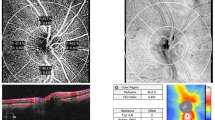Abstract
Purpose
To evaluate optic nerve head (ONH) characteristics in patients with exfoliation syndrome (EXS).
Methods
This was a cross-sectional, observational study in which 73 eyes from 73 patients with EXS and 93 eyes from 93 age-matched healthy subjects who met the inclusion criteria were included. Topographic measurements of the ONH and peripapillary retinal nerve fiber layer (RNFL) thickness were performed by confocal scanning laser ophthalmoscopy, using a Heidelberg retina tomograph. Outcomes of interest were studied by Student t test and χ-squared test.
Results
EXS patients and age-matched controls did not differ in ONH parameters. Nevertheless, the mean cup depth and height variation contour values were higher in the normal subjects (P = 0.07, P = 0.056, respectively). Mean RNFL thickness was 0.22 ± 0.06 mm in the EXS group and 0.26 ± 0.06 mm in the control group, (P = 0.001). Likewise, the RNFL cross-sectional area was significantly lower in exfoliative eyes (1.16 ± 0.35 mm2) than in those of the control group (1.31 ± 0.33 mm2) (P = 0.006).
Conclusions
No significant differences in ONH parameters between EXS patients and age-matched healthy subjects were observed; however, RNFL measurements in eyes with EXS showed lower values.
Similar content being viewed by others
References
Thorleifsson G, Magnusson KP, Sulem P, et al. Common sequence variants in the LOXL1 gene confer susceptibility to exfoliation glaucoma. Science 2007;317:1397–1400.
Jeng SM, Karger RA, Hodge DO, Burke JP, Johnson DH, Good MS. The risk of glaucoma in pseudoexfoliation syndrome. J Glaucoma 2007;16:117–121.
Leske MC, Heijl A, Hussein M, Bengtsson B, Hyman L, Komaroff E. Factors for glaucoma progression and the effect of treatment. The Early Manifest Glaucoma Trial. Arch Ophthalmol 2003;121:48–56.
Ritch R. Exfoliation syndrome: the most common identifiable cause of open angle glaucoma. J Glaucoma 1994;3:176–178.
Grodum K, Heijl A, Bengtsson B. Risk of glaucoma in ocular hypertension with and without pseudoexfoliation. Ophthalmology 2005;112:386–390.
Mitchel Pl, Wang JJ, Hourihan F. The relationship between glaucoma and pseudoexfoliation: The Blue Mountains Eye Study. Arch Ophthalmol 1999;117:1319–1324.
Yuksel N, Karabas L, Arslan A, Demirci A, Caglar Y. Ocular hemodynamics in pseudoexfoliation syndrome and pseudoexfoliation glaucoma. Ophthalmology 2001;108:1043–1049.
Ocakoglu O, Koyluoglu N, Kayiran A, Tamcelik N, Ozkan S. Microvascular blood flow of the optic nerve head and peripapillary retina in unilateral exfoliation syndrome. Acta Ophthalmol Scand 2004;82:49–53.
Martinez A, Sanchez M. Retrobulbar hemodynamic parameters in pseudoexfoliation syndrome and pseudoexfoliative glaucoma. Graefes Arch Clin Exp Ophthalmol 2008;246:1341–1349.
Wang L, Damji KF, Munger R, et al. Increased disk size in glaucomatous eyes vs. normal eyes in the Reykjavik Eye Study. Am J Ophthalmol 2003;135:226–228.
Healey PR, Mitchell P. Optic disk size in open-angle glaucoma: The Blue Mountains Eye Study. Am J Ophthalmol 1999;128:515–517.
Nicolela MT, Drance SM. Various glaucomatous optic nerve appearances: clinical correlations. Ophthalmology 1996;103:640–649.
Lusky M, Bosem ME, Weinreb RN. Reproducibility of optic nerve head topography with a new laser tomographic scanning device. Ophthalmology 1994;101:1044–1049.
Puska P. Unilateral exfoliation syndrome: conversion to bilateral exfoliation and to glaucoma: a prospective 10-year follow-up study. J Glaucoma 2002;11:517–524.
Hammer T, Schlötzer-Schrehardt U, Naumann GOH. Unilateral or asymmetric pseudoexfoliation syndrome? An ultrastructural study. Arch Ophthalmol 2001;119:1023–1031.
Davanger M, Ringvold A, Blika S. Pseudo-exfoliation, IOP, and glaucoma. Acta Ophthalmol (Copenh) 1991;69:569–573.
Yarangümeli A, Davutluoglu B, Köz OG, Elhan AH, Yaylaci M, Kural G. Glaucomatous damage in normotensive fellow eyes of patients with unilateral hypertensive pseudoexfoliation glaucoma: normotensive pseudoexfoliation glaucoma? Ophthalmology 2006;34:15–19.
Netland PA, Ye H, Streeten BW, Hernandez MR. Elastosis of the lamina cribrosa in pseudoexfoliation syndrome with glaucoma. Ophthalmology 1995;102:878–886.
Tomita G, Puska P, Raitta C. Interocular differences in optic disc configuration in the unilateral exfoliation syndrome. Acta Ophthalmol (Copenh) 1994;72:162–166.
Linner E, Schwartz B, Araujo D. Optic disc pallor and visual field defect in exfoliative and non-exfoliative, untreated ocular hypertension. Int Ophthalmol 1989;13:21–24.
Jonas JB, Papastathopoulos KI. Optic disc appearance in pseudo-exfoliation syndrome. Am J Ophthalmol 1997;123:174–180.
Tuulonen A, Airaksinen PJ. Optic disc size in exfoliative, primary open angle and low-tension glaucoma. Arch Ophthalmol 1992;110:211–213.
Puska P, Raitta C. Exfoliation syndrome as a risk factor for optic disc changes in non glaucomatous eyes. Graefes Arch Clin Exp Ophthalmol 1992;230:501–504.
Puska P, Harju M. Optic nerve head topography in nonglaucomatous, normotensive patients with unilateral exfoliation syndrome Graefes Arch Clin Exp Ophthalmol 2009;247:1111–1117.
Puska P, Harju M, Liebkind R. Peripapillary atrophy in the unilateral exfoliation syndrome. Graefes Arch Clin Exp Ophthalmol 2004;242:301–305.
Tezel G, Tezel TH. The comparative analysis of optic disc damage in exfoliative glaucoma. Acta Ophthalmol 1993;71:744–750.
Arnarsson A, Damji KF, Sverrisson T, Sasaki H, Jonasson F. Pseudoexfoliation in the Reykjavik Eye Study: prevalence and related ophthalmological variables. Acta Ophthalmol Scand 2007;85:822–827.
Puska P, Vesti E, Tomita G, Ishida K, Raitta C. Optic disc changes in normotensive persons with unilateral exfoliation syndrome: a 3-year follow-up study. Graefes Arch Clin Exp Ophthalmol 1999;237:457–462.
Mohammadi K, Bowd C, Weinreb RN, Medeiros FA, Sample PA, Zangwill LM. Retinal nerve fiber layer thickness measurements with scanning laser polarimetry predict glaucomatous visual field loss. Am J Ophthalmol 2004;138:592–601.
Zangwill LM, Chan K, Bowd C, et al. Heidelberg retina tomograph measurements of the optic disc and parapapillary retina for detecting glaucoma analyzed by machine learning classifiers. Invest Ophthalmol Vis Sci 2004;45:3144–3151.
Greenfield DS. Optic nerve and retinal nerve fiber layer analyzers in glaucoma. Curr Opin Ophthalmol 2002;13:68–76.
Yuksel N, Altıntas O, Celik M, Ozkan B, Caglar Y. Analysis of retinal nerve fiber layer thickness in patients with pseudoexfoliation syndrome using optical coherence tomography. Ophthalmologica 2007;221:299–304.
Gumus K, Bozkurt B, Sonmez B, Irkec M, Orhan M, Saracbasi O. Diurnal variation of intraocular pressure and its correlation with retinal nerve fiber analysis in Turkish patients with exfoliation syndrome. Graefes Arch Clin Exp Ophthalmol 2006;244:170–176.
Author information
Authors and Affiliations
Corresponding author
About this article
Cite this article
Cankaya, A.B., Beyazyildiz, E. Scanning laser ophthalmoscopic parameters of eyes with exfoliation syndrome. Jpn J Ophthalmol 54, 300–304 (2010). https://doi.org/10.1007/s10384-010-0829-6
Received:
Accepted:
Published:
Issue Date:
DOI: https://doi.org/10.1007/s10384-010-0829-6




